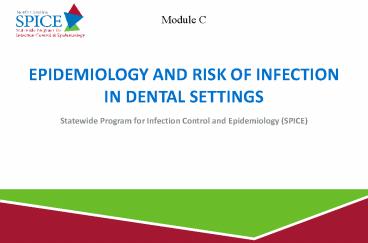Epidemiology and Risk of Infection in Dental Settings PowerPoint PPT Presentation
1 / 29
Title: Epidemiology and Risk of Infection in Dental Settings
1
Epidemiology and Risk of Infection in Dental
Settings
Module C
- Statewide Program for Infection Control and
Epidemiology (SPICE)
2
Objectives
- Discuss the infectious process through review of
the chain of infection. - Review methods for controlling transmission of
infection in dental settings. - Standard Precautions
- Describe steps for detecting and controlling
outbreaks.
3
Why Is Infection Control Important in Dentistry?
- Both patients and dental health care personnel
(DHCP) can be exposed to pathogens - Contact with blood, oral and respiratory
secretions, and contaminated equipment occurs - Proper procedures can prevent transmission of
infections among patients and DHCP
4
Chain of Infection
5
Infectious Agent or The Harmful Germ
- Bacteria (MRSA, VRE)
- Viruses (Influenza, Norovirus)
- Fungi (Candida, Aspergillis)
- Parasites (Giardia, pinworms)
- Arthropods (mites)
- Infestations, not infections
Infectious Agent
6
Infectious Agent or The Harmful Germ
- Disease Producing Characteristics
- Virulence
- Ability to grow and multiply
- Invasiveness
- Ability to enter tissue
- Pathogenicity
- Ability to cause disease
Infectious Agent
7
Reservoir or Hiding Places
- Where germs live, grow, and increase in numbers
- A person
- An animal
- Environment/Fomite
Reservoir
8
People as Reservoirs
- Blood
- Skin
- Digestive tract
- Mouth, stomach, intestines
- Respiratory tract
- Nose, throat, lungs
- Urinary tract
9
People as Reservoirs
People We Know Who Are Infected
People We Dont Know Who Are Infected
10
Portal of Exit or The Way Out
11
MODES of transmission
- Contact victim comes in contact with source
- Direct physical contact between source and
victim - Indirect victim contacts contaminated inanimate
objects - Droplet brief passage of infectious agent
- Airborne airborne phase in disease
dissemination - Common vehicle contaminated inanimate vehicle
serves as the vector for transmission to multiple
persons. - Vectorborne - Not associated with healthcare
transmission
12
Portal of Entry or The Way In
- Nose and Mouth
- GI Tract
- Urinary Tract
- Breaks in skin
- Cut, open sore, needlestick
13
Susceptible Person
- Age very young or older
- Stress
- Fatigue
- Poor nutrition
- Chronic illnesses
- Not properly vaccinated
- Open cuts, skin breakdown
- Immune suppressive medications
14
Knowledge Check
- A disease or condition when harmful germs get
into the body and cause pathology - Host
- Infection
- Reservoir
- Portal of exit
15
Knowledge Check
- Germs can be spread indirectly through
- Shared medical equipment
- Bloody gauze
- Needlesticks
- A and B only
- All of the above
16
Breaking The chain of infection
As long as the chain of infection remains intact,
infection will spread to others.
- Standard Precautions and Transmission-Based
Precautions
17
Elements of Standard Precautions
- Hand hygiene
- Use of personal protective equipment (PPE)
- gowns, gloves, mask, eye protection
- Safe injection practices
- Safe handling of potentially contaminated
equipment or surfaces - Respiratory hygiene/cough etiquette
18
Personal Protective Equipment (PPE)
- Wear gloves for potential contact with blood,
body fluids, mucous membranes, non-intact skin or
contaminated equipment. - Do not wear the same pair of gloves for more than
one patient - Do not wash gloves for the purpose of reuse
- Wear a gown to protect skin and clothing during
procedures or activities where contact with blood
or body fluids is anticipated. - Do not wear the same gown for more than one
patient - Wear mask and eye protection during procedures
that are likely to generate splashes or sprays of
blood or other body fluids.
19
Respiratory Hygiene/Cough Etiquette
- Post signs at entrances.
- Provide tissues and no-touch trash cans for
disposal in waiting areas. - Provide hand hygiene product in waiting areas.
- Offer a mask to symptomatic patients.
- Encourage ill patients to sit away from others.
20
(No Transcript)
21
Transmission of Mycobacterium tuberculosis
- Spread by droplet nuclei
- Immune system usually prevents spread
- Bacteria can remain alive in the lungs for many
years (latent TB infection)
22
Risk of TB Transmission in Dentistry
- Risk in dental settings is low
- Only one documented case of transmission
- Tuberculin skin test conversions among DHP are
rare
23
Preventing Transmission of TB in Dental Settings
- Assess patients for history of TB
- Defer elective dental treatment
- If patient must be treated
- DHCP should wear face mask
- Separate patient from others/mask/tissue
- Refer to facility with proper TB infection
control precautions
24
Outbreak Investigation
Outbreak occurrence of more cases of disease
than normally expected within a specific place or
group of people over a given period of time.
25
Definitions
- Endemic the usual presence of disease within a
geographic area - Epidemic (Outbreak) an excess over the usual or
expected occurrence of disease within a
geographic area - Pandemic epidemics that affected several
countries or continents (e.g., AIDS, pandemic
influenza, SARS)
26
Outbreaks Steps
- Verify diagnosis
- Establish case definition
- Review for cases case search
- Create a line listing
- Make an epi-curve
- Develop hypothesis
- Test hypothesis
- Implement control measures
- Evaluate control measures
- Disseminate information
a chart showing the number of persons who became
ill each day
27
Suspected OutbreakKnow Who to Call for
Assistance
- Facility Risk Manager
- Local Health Department first OR
- State Public Health Department
- (Raleigh 919-733-3419)
- Infection Control Assistance Statewide Program
for Infection Control and Epidemiology (SPICE),
spice_at_unc.edu, 919-966-3242
28
Knowledge Check
- Who should be notified of a suspected or known
communicable disease outbreak? - Risk Management
- Administration/Director
- Local Health Department
- All of the above
29
References
- Carrico R, ed. APIC Text of Infection Control and
Epidemiology. Online edition, APICWashington DC,
2011. - CDC Guidelines for Infection Control in Dental
Health-Care Settings-2003, MMWR 200352(No.
RR-17).

